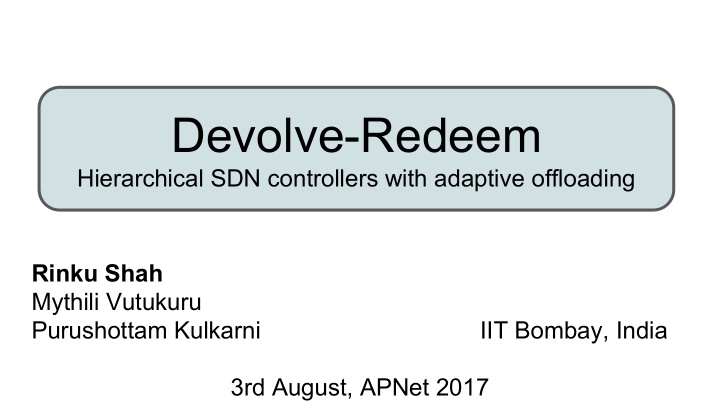



Devolve-Redeem Hierarchical SDN controllers with adaptive offloading Rinku Shah Mythili Vutukuru Purushottam Kulkarni IIT Bombay, India 3rd August, APNet 2017
Traditional network vs Software-defined network Traditional network vs Software-defined network ❏ Simplified network mgmt ❏ Ease of control-plane programming 2
How far can SDN Controllers scale? Openflow controllers support around 10K to 30K flows/sec * SDN networks have flow arrival rate of 100K to 1M flows/sec ** * Marcial P Fernandez and others. Comparing OpenFlow Controller Paradigms Scalability: Reactive and Proactive. Advanced information and applications, IEEE 2013. ** Kandula and others.. The nature of data center traffic: measurements & analysis. In Proceedings of IMC 2009 3
Controller Scaling technique - HORIZONTAL SDN controller scaling techniques Subset of switches assigned to each controller Need for synchronization between controllers Onix* Hyperflow** * Teemu Koponen and others. Onix: A Distributed Control Platform for Large-scale Production Networks. In Proc of the Conference on OSDI, 2010. ** Amin Tootoonchian and Yashar Ganjali. HyperFlow: A Distributed Control Plane for OpenFlow. In Proc of the Internet Network Management Conference on Research on Enterprise Networking, 2010. 4
Controller Scaling technique - VERTICAL SDN controller scaling techniques We call this technique, LSCO (Local state based compute offload) Devoflow* Kandoo** FOCUS*** LOCAL state egs Flow stats Switch mappings * Andrew R. Curtis and others. DevoFlow: Scaling Flow Management for High-performance Networks. In Proc of the SIGCOMM, 2011. ** Soheil Hassas Yeganeh and Yashar Ganjali. Kandoo: A Framework for Efficient and Scalable Offloading of Control Applications. In Proc of the Workshop on HoTSDN, 2012. *** Ji Yang and others. FOCUS: Function Offloading from a Controller to Utilize Switch Power. In Proc of IEEE Conference on NFV-SDN, 2016. 5
Controller Scaling techniques: Abstract view 6
Can Vertical Scaling perform better? 7
Key insight - GWLR state(Globally writable, but locally readable) GWLR state examples- 1. Tunnel Id (LTE EPC) 2. MPLS label 3. Session state 4. Network Policy state 8
GSCO (GWLR state based compute offload) Offload computations based on GWLR state Should we offload all GWLR state ? Synchronization cost may be high 9
GSCO (GWLR state based compute offload) Offload computations based on GWLR state Should we offload all GWLR state ? Synchronization cost may be high Centralized or LSCO or GSCO? 10
Key Contributions 1. GWLR state based offload technique a. GSCO (GWLR state based computation offload) 2. Application code is agnostic to scalability design 3. Framework that aids Adaptive Offload a. Designed Cost metric b. Implemented OVS feature for Compute Placement 11
Use-case: SDN based LTE-EPC application LTE-EPC procedures considered- 1. Attach Request 2. Service Request 12
Devolve-Redeem Design Devolve-Redeem design 13
A. User Input for LTE-EPC N L : # of Local states accessed N X : # of GWLR states accessed Msg-id, <N LR , N LW , N XR ,N XW , N GR , N GW , N RL > N G : # of Global states accessed N RL : # of Openflow Rules N LR N LW N XR N XW N GR N GW N RL Example LTE-EPC Messages Auth_Step_1 0 0 0 0 1 2 0 Send_UE_TEID 0 0 2 1 0 0 2 UE Context Release 2 0 0 1 0 0 3 Context Setup Response 0 0 1 1 0 0 2 14
B. Offload Cost-metric Cost_mode = State-access cost + Communication cost + Synchronization cost Cost = State-access cost + Communication cost + Synchronization cost Offload Mode Communication Synchronization Cost Cost Centralized RTT to ROOT 0 LSCO RTT to 0 LOCAL/ROOT GSCO RTT to Depends on LOCAL/ROOT current traffic mix 15
C. Enforce Offload module Cost metric calculator Msg-id, <N LR , N LW , N XR ,N XW , N GR , N GW , N RL > {<Msg-id, Offload-mode>} Offload module Generate Openflow rules This flow should be followed for each message 16
Experimental Setup Ongoing work 17
Questions to be answered? 1. What is the best offload scheme for a given traffic mix? 2. What is the impact of the offload choice on- a. Request Completion Time (Latency) b. Root Controller Traffic c. Root Synchronization Cost 18
Evaluation - Offload A: All GWLR state Evaluation ATTACH <= 20% GSCO = 1.4X Centralized 20% < ATTACH <= 60% LSCO = 1.27X Centralized ATTACH > 90% 19
Evaluation - Offload A: All GWLR state Evaluation ATTACH <= 20% GSCO = 1.4X Centralized 20% < ATTACH <= 60% LSCO = 1.27X Centralized ATTACH > 90% OFFLOAD CHOICE: Centralized/LSCO/GSCO DEPENDS ON CURRENT TRAFFIC MIX 20
Evaluation - Offload B: Subset of GWLR state ATTACH <= 20% GSCO = 2.11X Centralized Performance of “Offload A” 20% < ATTACH <= 60% for same traffic mix (1.4X) LSCO = 1.23X Centralized ATTACH > 90% 21
Evaluation - Offload B: Subset of GWLR state ATTACH <= 20% GSCO = 2.11X Centralized Performance of “Offload A” 20% < ATTACH <= 60% for same traffic mix (1.4X) LSCO = 1.23X Centralized ATTACH > 90% APPLICATION PERFORMANCE ALSO DEPENDS ON WHAT SUBSET OF GWLR STATE IS OFFLOADED 22
Ongoing work Ongoing work ● Evolving the cost metric using dynamic parameters Goals: ○ Improve accuracy ○ Reduce parameter capture & monitoring overheads ● Implement the Online Adaptive Offload framework 23
Conclusion ● Application performance depends on: ○ Controller Scalability design chosen ○ Subset of GWLR state offloaded ● There is need for an Online Adaptive Offload ● LSCO/GSCO reduces traffic to the ROOT controller , enabling controller scale 24
Recommend
More recommend